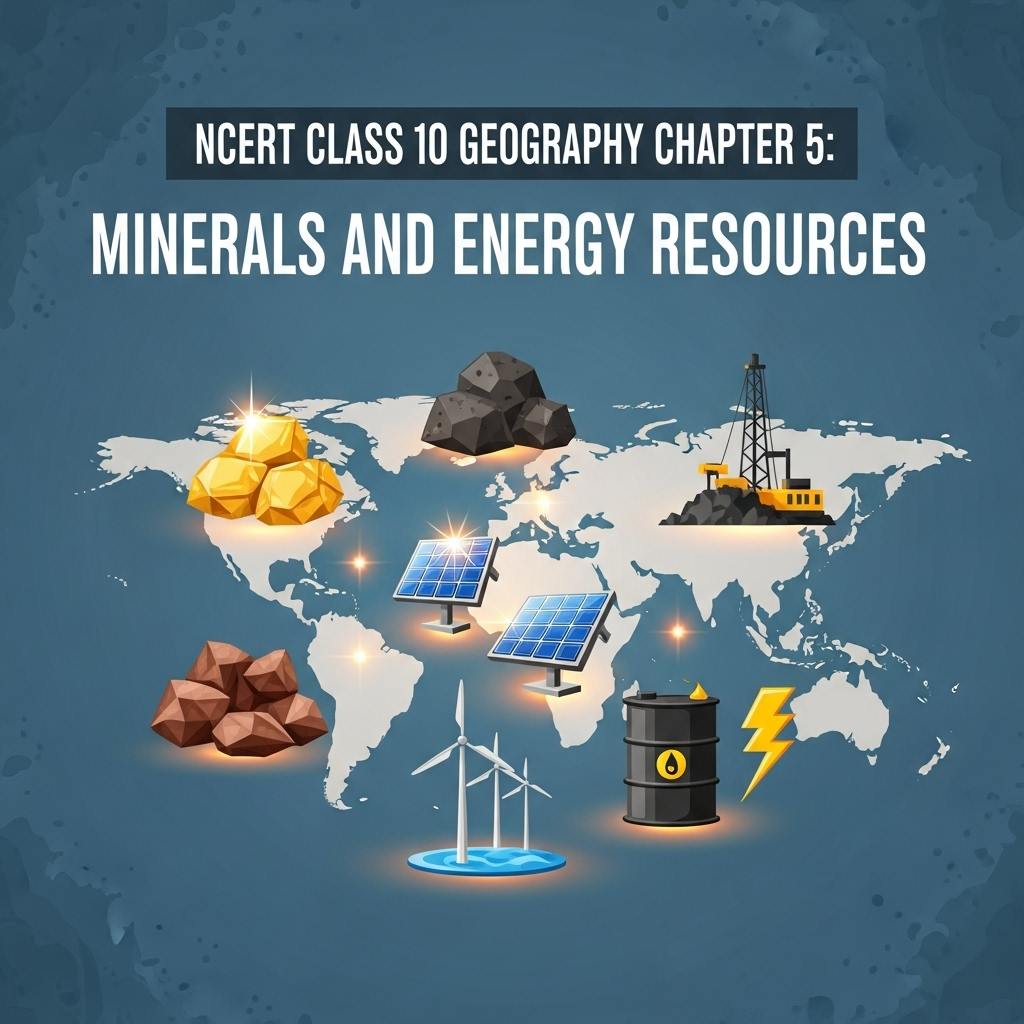Complete Solutions and Summary of Minerals and Energy Resources – NCERT Class 10, Geography, Chapter 5 – Summary, Questions, Answers, Extra Questions
Detailed summary and explanation of Chapter 5 'Minerals and Energy Resources' covering types and classification of minerals, mode of occurrence, distribution of major minerals like iron ore, manganese, bauxite, copper, coal, petroleum, natural gas, conventional and non-conventional sources of energy, environmental impacts, and energy conservation with all question answers and extra questions from NCERT Class X Geography.
Updated: 2 months ago
Categories: NCERT, Class X, Geography, Summary, Extra Questions, Minerals, Energy Resources, Coal, Petroleum, Natural Gas, Renewable Energy, Conservation, Chapter 5

Minerals and Energy Resources
Chapter 5: Geography - Complete Study Guide | NCERT Class 10 Notes & Questions 2025
Comprehensive Chapter Summary - Minerals and Energy Resources Class 10 NCERT
Overview
- Chapter Purpose: Explains minerals as essential for daily life, from pins to ships; derived from earth's crust via refinement. Indispensable for livelihood, decoration, rites. Figure 5.1: Mineral classification. India's rich but uneven distribution; peninsular rocks hold coal/metallics/mica; sedimentary flanks have petroleum; Rajasthan non-metallics. Key Insight: Minerals finite/non-renewable; conservation vital. Economy relies on them for industries/agriculture. Hazards like mining dangers emphasized. 2025 focus: Sustainable mining, energy shifts.
- Minerals in Daily Life: Toothpaste (silica/limestone/fluoride/titanium/mica); light bulb (many minerals); nutrition (0.3% intake but crucial). Dig deeper: Nutritional facts on labels.
- Definition & Variety: Mineral: Homogenous, naturally occurring with definable structure. Rocks: Mineral combinations; e.g., limestone single, most multi. Over 2000 identified; few abundant. Formation depends on physical/chemical conditions: Colors, hardness, lustre, density vary. Geographers study distribution/economics; geologists formation/age/composition.
- Mode of Occurrence: In ores (accumulation with elements; viable extraction). Forms: Igneous/metamorphic (veins/lodes: Tin/copper/zinc/lead); sedimentary (beds/layers: Coal/iron/gypsum/potash/sodium); decomposition (bauxite); alluvial/placer (gold/silver/tin/platinum); ocean (salt/magnesium/bromine/manganese nodules). Rat-hole mining (Meghalaya tribal, illegal per NGT).
- Exam Tip: Distinguish ferrous/non-ferrous; use maps (Fig. 5.5/5.10/5.12); know ores, belts.
- Broader Implications: Mining hazards (health/environment); conservation via tech/recycling; energy security amid fossil depletion.
Ferrous Minerals
- Iron Ore: Backbone industry; India abundant. Magnetite (70% iron, magnetic); Hematite (50-60%). 2018-19: 97% from Odisha/Chhattisgarh/Karnataka/Jharkhand. Belts: Odisha-Jharkhand (Badampahar/Gua/Noamundi); Durg-Bastar-Chandrapur (Bailadila export); Ballari-Chitradurga-Chikkamagaluru-Tumakuru (Kudremukh slurry to Mangaluru); Maharashtra-Goa (Marmagao export). Fig. 5.2: Iron mine. Kudre (horse), Bailadila (ox hump).
- Manganese: For steel/ferro-alloy (10 kg/tonne steel); bleaching/insecticides/paints. 2018-19 shares: Madhya Pradesh 33%, Maharashtra 27%, Odisha 16%, etc. Fig. 5.3: Pie chart.
Non-Ferrous Minerals
- Copper: Reserves deficient; malleable/ductile/conductor for cables/electronics/chemicals. Producers: Balaghat (MP), Khetri (Rajasthan), Singhbhum (Jharkhand). Fig. 5.4: Malanjkhand mines.
- Bauxite: Aluminium ore; from rock decomposition. Strength/light/conductive/malleable. Deposits: Amarkantak/Maikal/Bilaspur-Katni. 2018-19: Odisha 65% (Panchpatmali), etc. Fig. 5.5: Pie; Fig. 5.6: Bauxite mine. Napoleon fact: Aluminium prestige.
Non-Metallic Minerals
- Mica: Plates/leaves; thin layers; di-electric/insulating. Deposits: Chota Nagpur (Koderma-Gaya-Hazaribagh); Rajasthan (Ajmer); Andhra (Nellore).
- Limestone: Calcium/magnesium carbonates; sedimentary. For cement/iron smelting. 2018-19 shares: Madhya Pradesh 13%, etc. Fig. 5.7: Pie. Chota Nagpur storehouse.
Hazards of Mining
- Dust/fumes cause pulmonary diseases; roof collapse/inundation/fires. Water/land/soil pollution from waste/slurry. Fig. 5.8: Air pollution. Stricter laws to prevent 'killer industry'. Jharia shifting due to fires.
Conservation of Minerals
- 1% workable crust; slow formation vs consumption. Finite/non-renewable; costs rise/quality falls. Planned use, low-grade tech, recycling, substitutes. Dig deeper: Substitutes list.
Energy Resources
- Conventional: Coal/petroleum/natural gas/electricity/hydel/thermal. Rural: Firewood/dung (70%, depleting forests).
- Coal: Fossil fuel; power/industry/domestic. Forms: Peat (low carbon/moist); Lignite (brown, Neyveli); Bituminous (commercial/metallurgical); Anthracite (hard). Gondwana (200M yrs: Damodar/Jharia/Raniganj/Bokaro/Godavari/Mahanadi/Son/Wardha); Tertiary (55M: Meghalaya/Assam/Arunachal/Nagaland). Fig. 5.9: Coal mines. Bulky, near fields.
- Petroleum: Heat/lighting/lubricants/raw materials. Tertiary rock; anticlines/fault traps. Mumbai High/Gujarat/Assam (Ankleshwar/Digboi/Naharkatiya/Moran-Hugrijan). Nodal for textiles/fertilizers/chemicals.
- Natural Gas: With petroleum; fuel/power/fertilizer/chemical/transport (CNG)/cooking (PNG). Reserves: Mumbai High/Cambay/Krishna-Godavari. HVJ pipeline (1700 km); now 18,500 km to 34,000 km 'One Nation One Grid' by GAIL.
- Electricity: Per capita index. Hydel (renewable, fast water: Bhakra Nangal/Damodar/Kopili); Thermal (fossil: Coal/petroleum/gas). Name river projects/dams. Collect state plants/map. Fig. 5.12: Nuclear/thermal map.
Non-Conventional Sources
- Fossil shortages/environment issues; renewable push. India abundant sunlight/water/wind/biomass.
- Nuclear: Uranium/Thorium (Jharkhand/Rajasthan/Monazite Kerala). 6 stations; locate states.
- Solar: Tropical; photovoltaic to electricity. Rural reduce firewood/dung. Big plants; collect new ones. Fig. 5.10: Solar milk tester.
- Wind: Tamil Nadu (Nagarcoil-Madurai cluster); Andhra/Karnataka/Gujarat/Kerala/Maharashtra/Lakshadweep. Nagarcoil/Jaisalmer effective. Fig. 5.11: Wind mills.
- Biogas: Shrubs/waste/dung; higher efficiency vs kerosene/charcoal. Gobar plants: Energy/manure; prevent tree/dung loss. Fig. 5.12: Biogas plant.
- Geothermal: Earth's heat; hot springs (Parvati Manikaran/Puga). Experimental projects.
Conservation of Energy
- Economic development needs energy; India low efficiency. Sustainable: Conservation/renewables. Public transport, switch off, power-saving, non-conventional. 'Energy saved is produced'.
SEO Note: Why This Guide?
Top-ranked for 'Minerals and Energy Resources Class 10 notes 2025'—free, with 60 Q&A from PDF, quizzes. Integrates mineral insights.
Key Themes
- Distribution Variations: Geological/time factors.
- Resources Details: Occurrence, uses, maps. Fig. 5.5: Distribution map.
- Conservation Links: Tech/recycling for sustainability.
- Critical Thinking: Why rat-hole illegal? Energy shifts?
Cases for Exams
Use Fig. 5.3 for shares; discuss mining hazards; analyze NRCP but chapter focus conservation.
Exercises Summary
- Focus: Expanded to 60 Q&A from PDF: 20 short (2M), 20 medium (4M), 20 long (8M) based on NCERT exercises + similar.
- Project Idea: Crossword for minerals; map marking of mines/fields.
Group Discussions
No forum posts available.


